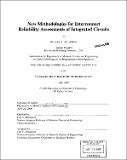| dc.contributor.advisor | Carl V. Thompson. | en_US |
| dc.contributor.author | Hau-Riege, Stefan P. (Stefan Peter), 1970- | en_US |
| dc.contributor.other | Massachusetts Institute of Technology. Dept. of Materials Science and Engineering. | en_US |
| dc.date.accessioned | 2006-02-02T18:47:10Z | |
| dc.date.available | 2006-02-02T18:47:10Z | |
| dc.date.copyright | 2000 | en_US |
| dc.date.issued | 2000 | en_US |
| dc.identifier.uri | http://hdl.handle.net/1721.1/31092 | |
| dc.description | Thesis (Ph.D.)--Massachusetts Institute of Technology, Dept. of Materials Science and Engineering, 2000. | en_US |
| dc.description | Includes bibliographical references (leaves 245-251). | en_US |
| dc.description.abstract | The stringent performance and reliability demands that will accompany the development of next-generation circuits and new metallization technologies will require new and more accurate means of assessing interconnect reliability. Reliability assessments based on conventional methodologies are flawed in a number of very important ways, including the disregard of the effects of complex interconnect geometries on reliability. New models, simulations and experimental methodologies are required for the development of tools for circuit-level and process-sensitive reliability assessments. Most modeling and experimental characterization of interconnect reliability has focused on simple straight lines terminating at pads or vias. However, laid-out integrated circuits usually have many interconnects with junctions and wide-to-narrow transitions. In carrying out circuit-level reliability assessments it is important to be able to assess the reliability of these more complex shapes, generally referred to as "trees". An interconnect tree consists of continuously connected high-conductivity metal within one layer of metallization. Trees terminate at diffusion barriers at vias and contacts, and, in the general case, can have more than one terminating branch when the tree includes junctions. We have extended the understanding of "immortality" demonstrated and analyzed for straight stud-to-stud lines, to trees of arbitrary complexity. We verified the concept of immortality in interconnect trees through experiments on simple tree structures. This leads to a hierarchical approach for identifying immortal trees for specific circuit layouts and models for operation. We suggest a computationally efficient and flexible strategy for assessment of the reliability of entire integrated circuits. The proposed hierarchical reliability analysis can provide reliability assessments during the design and layout process (Reliability Computer Aided Design, RCAD). Design rules are suggested based on calculations of the electromigration-induced development of inhomogeneous steadystate mechanical stress states. Failure of interconnects by void nucleation in single-layermetallization, as well as failure by void growth in the presence of refractory metal shunt layers are taken into account. The proposed methodology identifies a large fraction of interconnect trees in a typical design as immune to electromigration-induced failure. To complete a circuit-level-reliability analysis, it is also necessary to estimate the lifetimes of the mortal trees. We have developed simulation tools that allow modeling of stress evolution and failure in arbitrarily complex trees. We have demonstrated the validity of these models and simulations through comparisons with experiments on simple trees, such as "L"- and "T"-shaped trees with different current configurations. Because analyses made using simulations are computationally intensive, simulations should be used for analysis of the least reliable trees. The reliability of the majority of the mortal trees can be assessed using a conservative default model based on nodal reliability analyses for the assessment of electromigration-limited reliability of interconnect trees. The lifetimes of the nodes are calculated by estimating the times for void nucleation, void growth to failure, and formation of extrusions. The differences between straight stud-to-stud lines and interconnect trees are studied by investigating the effects of passive and active reservoirs on electromigration. Models and simulations were validated through comparisons with experiments on simple tree structures, such as lines broken into two limbs with different currents in each limb. Models, simulations and experimental results on the reliability of interconnect trees are shown to yield mutually consistent results. Taken together, the results from this research have provided the basis for the development of the first RCAD tool capable of accurate circuit-level, processing sensitive and layout-specific reliability analyses. | en_US |
| dc.description.statementofresponsibility | by Stefan P. Hau-Riege. | en_US |
| dc.format.extent | 251 leaves | en_US |
| dc.format.extent | 12214838 bytes | |
| dc.format.extent | 12248027 bytes | |
| dc.format.mimetype | application/pdf | |
| dc.format.mimetype | application/pdf | |
| dc.language.iso | eng | en_US |
| dc.publisher | Massachusetts Institute of Technology | en_US |
| dc.rights | M.I.T. theses are protected by copyright. They may be viewed from this source for any purpose, but reproduction or distribution in any format is prohibited without written permission. See provided URL for inquiries about permission. | en_US |
| dc.rights.uri | http://dspace.mit.edu/handle/1721.1/7582 | |
| dc.subject | Materials Science and Engineering. | en_US |
| dc.title | New methodologies for interconnect reliability assessments of integrated circuits | en_US |
| dc.type | Thesis | en_US |
| dc.description.degree | Ph.D. | en_US |
| dc.contributor.department | Massachusetts Institute of Technology. Department of Materials Science and Engineering | |
| dc.identifier.oclc | 47849880 | en_US |
| dc.audience.educationlevel | | |
